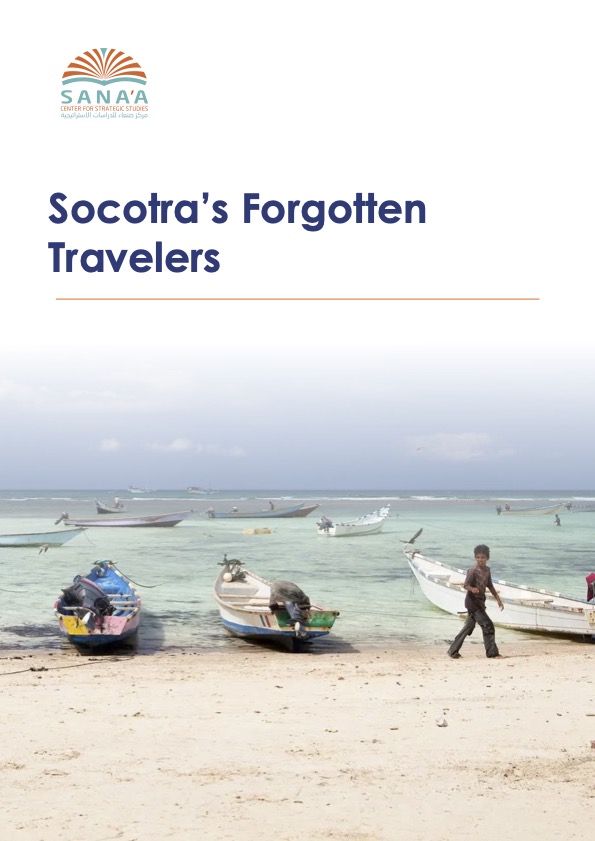Yemen’s civil war has cast a shadow over Socotra, the Indian Ocean archipelago governorate, and the daily lives of its residents. Before the war began in 2014, there were three flights to and from the islands. The first was operated by Yemenia Airways, the second by small local operator Felix Airways, and the third by the Yemeni Ministry of Defense, dedicated to transporting soldiers, their families, and people with limited income. After the start of the conflict, the ministry and Felix Airways halted their flights, while Yemenia Airways remained operational, but with interruptions that sometimes lasted for months. Ticket prices have risen steadily, with a one-way ticket from Socotra to Mukalla in Hadramawt now more than three times its pre-war price.
Residents have resorted to using fishing boats to travel to and from the islands, which lie some 210 miles from the Yemeni mainland. In good conditions, a boat takes two to three days to reach Socotra from Al-Mahra or Hadramawt. However, the trip is notoriously unsafe, with breakdowns and turbulent weather causing delays and disaster. Some boats have sunk with children, women, and the elderly on board; others were lost at sea for days or even weeks on end. I had such an experience in 2019 when the vessel I was on broke down 100 miles from the coast of Al-Mahra governorate with 50 men, nine women, and four children on board. The boat remained at sea for seven days until the Saudi-led military coalition organized a rescue in coordination with the Yemeni navy.
Despite these risks, several factors push residents to take their chances. First is the high cost of flights. Before 2011, tickets were less than US$50 for a one-way journey, but prices rose steadily after 2015 and have now reached US$150. At the same time, the economic collapse of recent years has had as heavy an impact in Soctora as in other government-held areas: public salaries have gone unpaid for long periods, the local currency has heavily depreciated, and exports have been held up due to the Houthis’ effective blockade of government-held ports. Attendant hardship has pushed the rising cost of flights out of reach for many residents.
Flights have also become few and far between. After 2015, Yemenia Airways stopped operating flights for almost a year due to the outbreak of war before gradually resuming service with a reduced schedule. One flight a week ran between Socotra and Seyoun in Wadi Hadramawt, but frequent interruptions could last for one or two months. The situation only improved after the worst of the Covid-19 pandemic, when flights began to return to a fixed schedule, with one weekly return flight from Aden via Mukalla. At the beginning of 2024, Yemenia increased the number of flights to two per week to and from Aden, Mukalla, and Al-Ghaydah in Al-Mahrah. In addition, there have been two weekly flights between Socotra and Abu Dhabi operated by Sharjah-based Air Arabia since 2017, and ever since Saudi Arabia stationed military forces on the island in 2018, its military aircraft have, from time to time, carried local passengers from Socotra to Al-Ghaydah.
Problems Persist
However, beyond these services operated by the UAE and Saudi Arabia, the government has done little to alleviate islanders’ isolation. Throughout the conflict, politicians have been preoccupied with personal disputes and squabbles while the suffering of citizens has deepened. Their privileged position gives them easy access to expensive flights and blinds them to the problems of ordinary people. For their part, Socotrans believe it is the war that has forced most people into dangerous travels by sea. Still, neither local nor central authorities have given the issue proper attention.
Moreover, the failure of successive authorities to regulate sea travel (at least until political conditions stabilize and state institutions resume functioning) has exacerbated the tragic situation and loss of life. It is telling that there are no official figures for victims of sea travel, even amid suspicions that the cases of missing persons have become more frequent. Instead, locals are simply left to share their stories about the suffering they’ve experienced on the seas.
Fatima was on a large boat carrying 70 men, 10 women, and one child when it ran into trouble at sea in 2016. “The boat was loaded beyond its capacity. We stopped in the middle of the sea twice and were told something was wrong with the boat. But on the last night, everyone felt the end was coming, especially shortly before dawn, when I woke up to the voices, screams, and yelling of all the passengers. Somebody asked the passengers to save themselves and get into the small lifeboats on the boat.” She added: “We got into these lifeboats while some families remained onboard because the situation was difficult, and darkness overwhelmed the scene. We did not know who got into the lifeboats and who did not. We used planks of wood to move the lifeboats away from the boat as it was about to sink. As we moved away, and as the morning light dispelled the darkness of the night, we saw some young men clinging to the edges of the boat as it sank. Bit by bit, it disappeared with women, children, and men still on board, either because they were unable to jump into the lifeboats, or because they had been knocked unconscious. We remained on those lifeboats for days until we were rescued and reached land.”
Another survivor from that disaster says he only saw around a dozen women and six children in the rescue boat. “The magnitude of the tragedy we experienced distracted our minds for a long time. Many details have disappeared from my memory now because of the horror of the suffering we endured.”
Abdullah, a student at the Faculty of Law at Hadramawt University, described the travel situation. “I have traveled by sea many times, even though I suffer from seasickness and severe nausea while traveling. But my family’s income is not enough to afford an airline ticket.” On one occasion in 2021, he traveled with around 30 other people on board, including men, women, and children. “The boat departed in the afternoon, and when we had gone around 100 miles, a technical malfunction occurred during a storm in the middle of the night. We waited at sea while our boat floated aimlessly for five days, then we were found by an Omani warship, which took us to the Omani mainland. After that, I decided not to travel by sea again, though I was forced again to travel via boat to finish my university studies.”
A Socotra resident who preferred to remain anonymous talked of losing his teenage brother to the sea in 2016: “We’re still hoping that one day we will see my brother returning, waving his hands on a happy return, because we have not found physical evidence of his death yet,” he said, his eyes welling up as he spoke. A captain, who also preferred to remain anonymous, said the problem of overcrowding on boats was difficult to avoid given the precarious situation most people are living in now on Socotra. “The current conditions forced us to allow passengers to board the ship with us, although the dangers of the sea are many. But what to do?”
Proposed Solutions
The authorities need to understand their duty to protect people’s lives. Several proposals are offered here, some as short-term solutions and others as long-term approaches. To begin with, the governorate authorities in Socotra should regulate sea travel by limiting the number of departure points. Passenger vessels should be inspected before they set off, captains should be approved based on their competence, the number of passengers should be strictly regulated, and weather conditions should be assessed in advance.
The central government should press Yemenia Airways to lower ticket prices to make them affordable to Socotrans. Double booking should be stopped, schedules should be adhered to, and exit row seats should be identified in planes in case of emergency. Public campaigns should be organized to raise awareness of the importance of safety at sea and the dangers of overcrowding or setting sail without knowing the weather conditions.
In the long term, the authorities should explore the possibility of purchasing a private plane that could transport Socotra residents to the nearest point on the Yemeni mainland, and the central government should be lobbied to assist in this endeavor. Socotra’s tourism revenues could be used to pay to operate this service. Authorities might also consider contracting international air carriers to fly to the island from regional destinations such as Jeddah, Salalah, and Indian airports. These could serve as transit points for travelers going to and from Socotra. Finally, the local and central government should consider the possibility of passenger ships, including small cruise liners, stopping at Socotra. The archipelago, with its unique ecosystem and plant life, has been recognized as a UNESCO World Heritage site since 2008. Perhaps now is the time to start channeling demand for tourism to serve the interests and needs of the local population.
This commentary was produced as part of the Yemen Peace Forum, a Sana’a Center initiative that seeks to empower the next generation of Yemeni youth and civil society activists to engage in critical national issues.

 اقرأ المحتوى باللغة العربية
اقرأ المحتوى باللغة العربية
